|
Friday, April 27 – Selcuk to Pamukkale
We were up early and had breakfast on the rooftop terrace. The place was abuzz with excitement about the stork. Her babies hatched and she is able to fly around again. Nazmi, one of the hotel owners was crawling up on a chair trying to take pictures of the stork on the roof. Bill tried to get his attention and tell him that we had NOT prepaid our hotel bill and still owed him 180 YTL. But Nazmi was only interested in the stork. Finally Erdal, the other owner, appeared and Bill asked him to call Mehmet in Istanbul to settle the issue. It turned out that we did indeed owe for the room, so Erdal took our money, rubbed it on his chin and threw it on the ground. I looked at him strangely and he explained that it is a Turkish custom to bless the first money you make each day and more will follow. We loved the Hotel Bella, with its crazy owners, storks and interesting guests.
Grand Wonders big bus picked us up about 9:45 and we were off to Pamukkale. The bus was taking a tour group for a day trip, but we were just passengers to Pamukkale. The roads were good, but the towns we passed through were dismal—lots of Soviet-style apartment buildings, each with ugly solar water heaters and satellite dishes installed on the roofs. However, the people-watching was superb — families packed on tractors, schoolboys in black suits, herds of weird-looking goats, leather-faced farmers and round women.
The bus had a device that beeped when the bus exceeded a certain speed (88kpm). The tourist industry here is serious about safety. We had a “comfort stop” at a sad, has-been souvenir mall. Bill and I walked behind the building for a view of a beautiful fertile valley. As we neared our destination, Pamukkale, we could see the snow-white travertines in the distance. We couldn’t wait to explore them.
Mehmet, the owner of our hotel—the Melrose Allgau—picked us up at the bus station and took us a short distance to the hotel. On the way we passed his two daughters (7 and 9) walking home from school for lunch. We mentioned to Mehmet that we had read that his wife is an excellent cook. Mehmet agreed and said she is also “a very clever woman”. Heck – she was absolutely amazing!
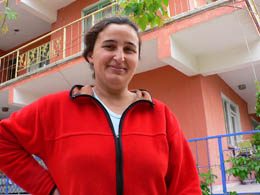
Ummu, the clever gal who ran our hotel |
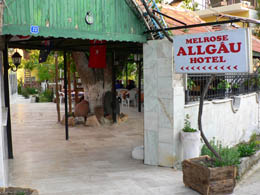
Our Hotel |
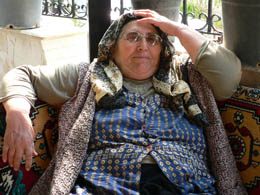
Ummu’s mom (assistant cook and gardner) |
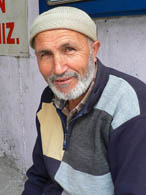
Ummu’s dad (and our driver) |
Ummu, Mehmet’s wife, met us at the gate and took full charge of us. She cooked a wonderful lunch for us—delicious tomato soup, salad, and stuffed grape leaves. (She called them “wine” leaves.) Then she told us how to get to the travertines and Hierapolis, the ancient spa city.
After lunch we put our swimsuits under our clothes and walked into Pamukkale where we visited the ancient city of Hierapolis and the famous travertines. It was declared a UNESCO World Heritage Site in 1990. We arrived at the north entrance about 2 in the afternoon and couldn’t believe our eyes. Pamukkale means “cotton castle” in Turkish, which describes the travertines perfectly. The entire hillside facing the town is covered in gleaming white calcium deposits that look like they’re dripping down the slope. (This unique geological phenomenon occurres when hot water, rich with dissolved Calcium Bicarbonate, cools and gives off CO2, dropping Calcium carbonate, which hardens and makes little dams and rivulets for the continuing flow.) Cleopatra came here often for spa treatments. In fact, Romans came from all over the Roman Empire to the healing waters of Hierapolis.
From a distance, the tourists looked liked penguins on an icy hillside going up and down the travertines to Hierapolis. We paid our entrance fee and removed our shoes (as required) and then walked up the 250 meters of calcium to the plateau on our tender feet. On the way up we passed large tour groups heading back to their buses. It looked weird – I’ll let the photos speak for themselves.
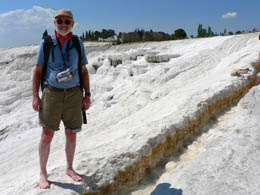
Bill, barefooted on the travertines |
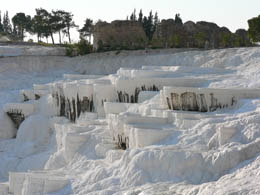
It was a hot day – can this be real? |
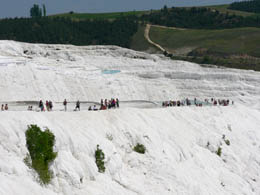
Penguin tourists |
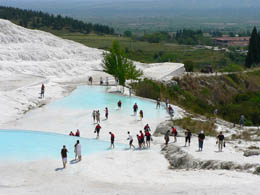
The pools of water are hot! |
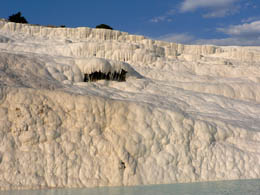 Unbelievable site! |
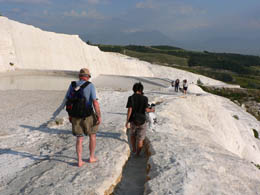
Bill going down the trail |
At the top of the hill was the Sacred Pool (mineral baths). It was built in 190 B.C. as a cure center by Eumenes II, the king of Pergamum. Later, the Romans took over, followed by the Byzantines. Then several different earthquakes drove it into ruins. Cleopatra bathed in the waters. The Sacred Pool was once at the center of the city of Herapolis, but now is housed in a typical 1960’s motel cleverly named the Pamukkale Motel. The motel business is closed – government bought it out. For a fee of 18 YTL ($13), you can jump into the pool with submerged columns and archways. It didn’t look appealing to us because it was filled with sweaty, fat people wallowing about. We opted for a Magnum ice cream bar instead.
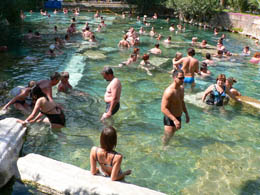
Cleopatra’s Spa |
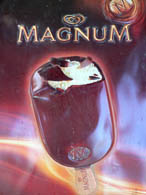
Eat your heart out Cleopatra |
After a Magnum break, we explored Hierapolis. Luckily there were only a few other people at the place – the tour buses had gone home, so we had it to enjoy pretty much by ourselves. Hierapolis stands out among the ancient cities because it was built out of locally-quarried stone instead of marble. The bad news is that it has a darker, more worn look to it. The good news is that most of the city still remains. Other cities, built of marble, were carted away and recycled into new structures.
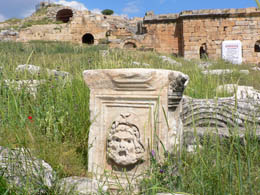
Hierapolis |
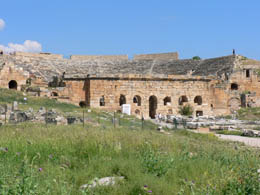
Hierapolis (Bath house, now the museum) |
Our favorite spot was the Roman theatre, which is by far the best-preserved theatre in Turkey (and probably Greece and Italy as well). Most of the stage was still standing along with a few statues somewhat intact.
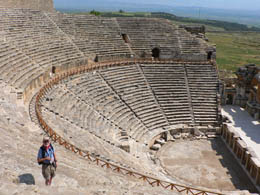
Theatre, all to ourselves |
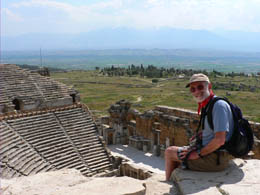
Bill in the theatre balcony seating |
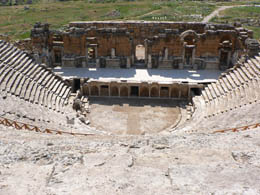
Theatre with the stage still intact |
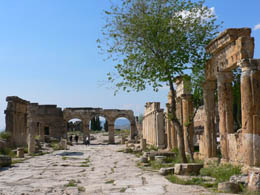
Streets of Hierapolis |
We walked down the Hierapolis main street, now strewn with marble slabs and peppered with wildflowers – but there’s enough left to imagine the grandeur of this place.
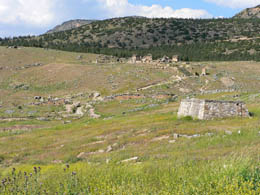
Once the suburbs of Hierapolis |
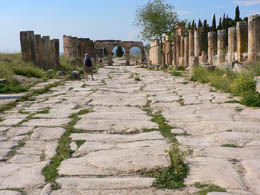
Main road through town |
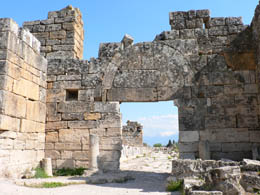
Hierapolis |
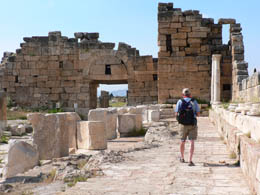
Bill strolling through town |
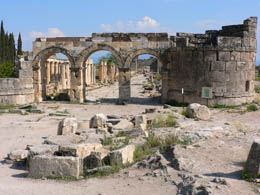
Gates to the city |
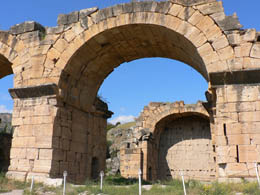
Those Romans can really do arches! |
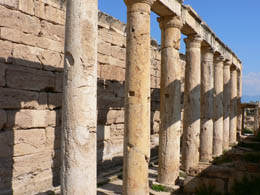
Columns |
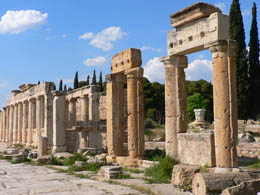
More Columns |
We walked through the Arch of Domitian to the Necropolis, a Hellenistic cemetery loaded with huge marble tombs. Hierapolis is noted for its cemetery. Most of the sarcophaguses (or is it sarcophagi) have been damaged by earthquakes.
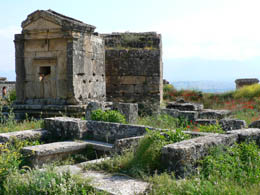
Scenes from the Necropolis at Hierapolis |
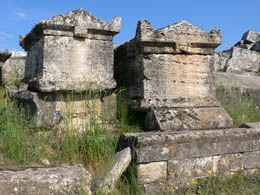
Scenes from the Necropolis at Hierapolis |
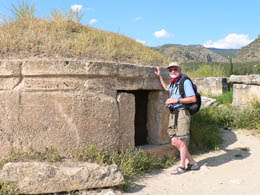
Scenes from the Necropolis at Hierapolis |
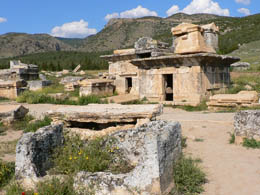
Scenes from the Necropolis at Hierapolis |
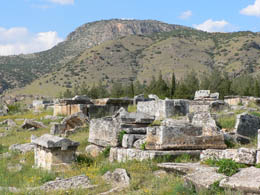
Scenes from the Necropolis at Hierapolis |
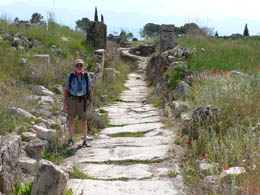
Bill walks back through town |
We walked back through the ancient city to the bathhouse, where a wonderful museum is now located. It was well organized -- divided into 3 separate sections: statues, small things (oil lamps, pots, coins) and theatre life.
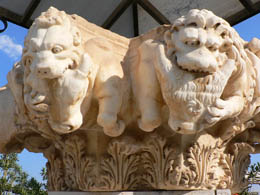
Lions eating bulls (top of a column) |
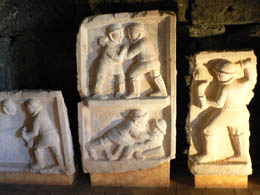
Stone carving of gladiators |
We walked back to the hotel. On the way a group of neighborhood kids wanted us to take their pictures, which I obliged – always a good way to connect without a common language. Aren’t they adorable?
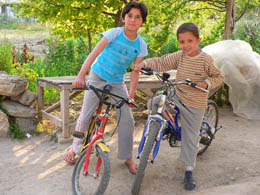
The kids who hung outside out hotel |
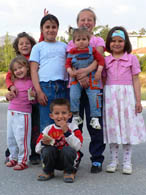
More kids from the neighborhood |
At the hotel we had a beer with two cute Aussie gals, Kate and Mardi (who are both 27). They are here to celebrate ANZAC Day in Gallipolis (and to party and drink a lot – such fun girls).
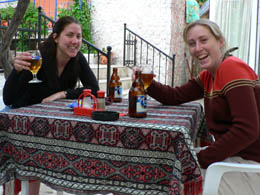
Kate and Mardi – I miss them! |
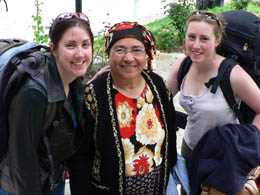
Kate and Mardi with Ummu’s Mom |
This hotel is the friendliest place. The beautiful garden has grape vines, trees, a lovely pool, and three tree houses. Our waiter, Kazim, is a dancer and artist. Born on a farm in rural Turkey, he had to get out—“Do I look like a farmer?” He asked us. “Certainly not,” I replied and then we laughed.
Ummu made a killer dinner for us — yogurt soup, salad, and a chicken/lamb dish cooked with eggplant and okra. Delicious! Ummu told us that the latest edition of Lonely Planet mistakenly said that their hotel was owned by a German couple. She’said, “I’m going to have to start serving snitzel.” This is very unfortunate because Lonely Planet will probably hurt their business. People live and die by the holy word of Lonely Planet and to get the facts so wrong is a horrible thing to do to good, hard-working people trying to make a living.
Stuffed and very happy, we went up to our room early to do laundry and catch up on my journal.
Saturday, April 28 – Pamukkale and Aphordisias
Another magical day to report. After a nice breakfast at the hotel, Ummu packed our lunch and had her father drive us to the ancient city of Aphordisias, two hours away. We rode along beautiful, winding mountain roads and saw farmers in the fields, shepherds, and orchards with trees covered in white blossoms. Spring was everywhere; only a couple scary close calls on the road. (Later, Ummu asked us about her father’s driving – We gave him a good report.)
Aphrodisias was our favorite ancient city in Turkey. Only a handful of tour buses find their way to this isolated and beautiful city. The signs describing the sites are so well done you don’t need a guide.
Aphrodisias dates back over 7,000 years. Aphrodisias was laid out on a grid plan and by the late first century B.C. the construction of monumental public buildings began. A local citizen, Zoilus, put up the funds for the construction of the theater, the main public square, the Temple of Aphrodite and several other city landmarks. Zoilus had one heck of a story. Pirates captured him, made him a slave and then Octavian Augustus, the first Roman emperor, acquired him (either bought him or inherited him). Zoilus was eventually freed and returned to his hometown of Aphrodisias a wealthy man with powerful connections in the capital. He used his connections and his money to put Aphrodisias on the map. By the third century AD, it had become the capital of the Roman province.
Our first view of the city was the main gate and marketplace.
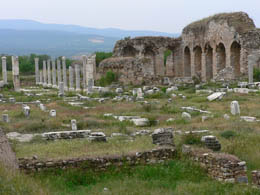
Tiberius Portico and Agora gate |
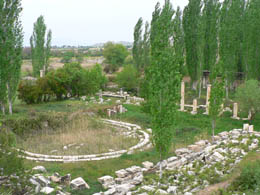
Sebasteion |
The theater, with a seating capacity of 7,000 people, was used for both dramatic performances and public assemblies. We passed a group of Turkish school kids climbing up and down the aisles through the theater seating. Most of them said “Hello” to us, one said “Bonjour.” Another said “USA—Shaquille O’Neal—very good basketball player.” The school kids are very friendly and make us laugh with their comments.
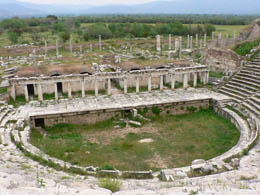
The Theater |
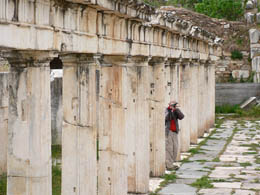
Bill on stage |
Next to the theater were the Tetrastoon and theater bath. The baths were an important center of public life where the citizens went to bathe, relax and be entertained.
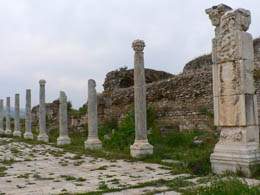
Theater baths |
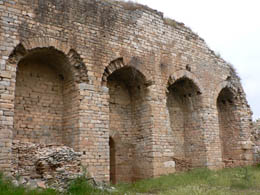
Theater baths |
Across town were the Hadrian Baths, built in the early 2nd century. They were dedicated to emperor Hadrian (AD 117-38). Now that guy really got around Turkey.
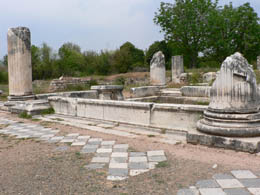
Hadrian Baths |
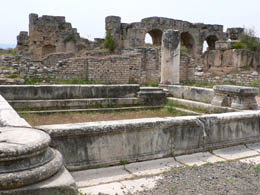
Hadrian Baths |
We walked down Aphrodisias’ main thoroughfares and through the town’s enormous marketplaces (North and South Agora).
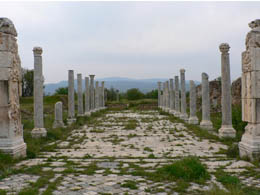
Main Street Aphrodisias |
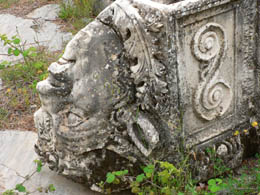
A lost head |
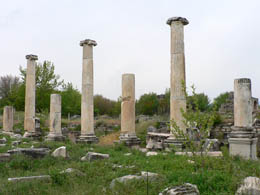
Once lined with shops |
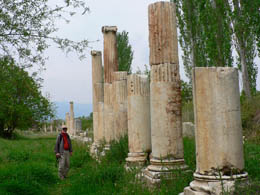
Where have all the shops gone? |
Later, a little lost, we went back to the theater to eat the sandwiches Ummu prepared for us. Lonely Planet’s map wasn’t very helpful, but we managed to see everything.
The Stadium of Aphrodisias was immense with space for 30,000 people. It was built in the first century A.D. for the traditional Greek athletic contests, such as foot races, long-jumping, wrestling, discus and javelin throwing. It was also used for gladiator combats and wild-beast fights. Inscriptions carved on the seats designate the reserved seating for groups such as the tanners and the goldsmiths as well as for specific individuals.
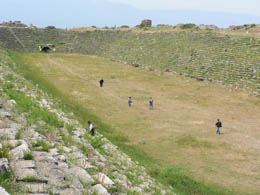
The Stadium |
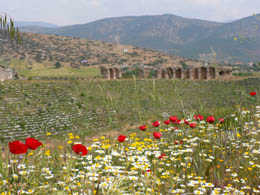
The Stadium awash in wildflowers |
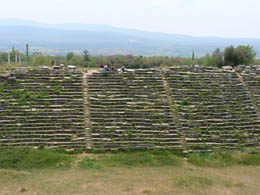
Stadium seating |
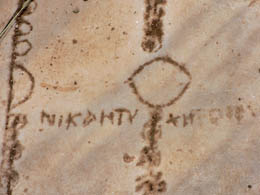
Reserved seating |
The Council House (Bouleuterion), built in the late first century, was like a modern town hall, seating about 1750 people. It was used as the place where the administrative council met and also as a multi-purpose indoor theater and concert hall.
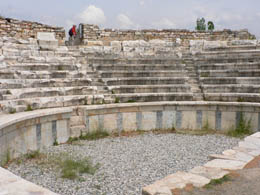
Bouleuterion |
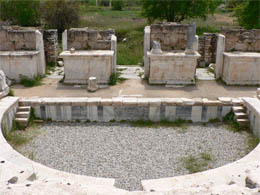
Bouleuterion |
The once magnificent Temple of Aphrodite was another project funded by Zoilus, slave turned leading citizen. Later, around 500 A.D., this pagan temple was converted into a Christian church.
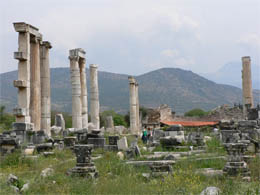
Temple of Aphrodite |
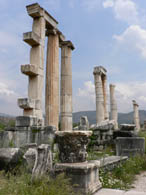
Temple of Aphrodite |
Our last stop was the Tetrapylon – a monumental gateway built in 200 A.D. on the north- south road through town. It leads directly to the front courtyard of Aphrodite’s Temple. Just imagine the processions that went through this gateway.
The gateway was painstakingly pieced back together. 85% of the original marble blocks survived. In the shadow of this huge gateway is a simple grave made from broken pieces of white marble. The man buried here is an American, Kenan T. Erim. He was a professor from New York University who dedicated his life to the ancient city of Aphrodisias. He directed the archaeology work here from 1961 to 1990 that dug Aphrodisias out of the rubble and made it famous today.
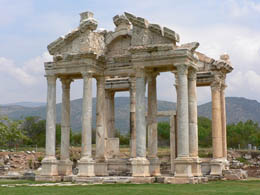
Tetrapylon (gateway) |
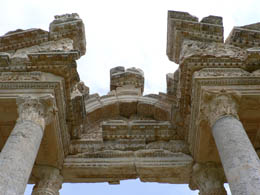
Arches of the gateway |
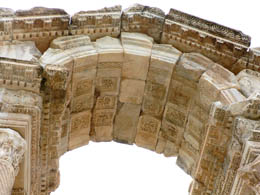
Arches of the gateway |
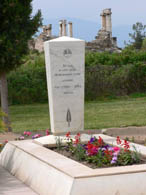
Professor Erim’s grave |
We were disappointed that the museum was closed for restoration. On the way out, we stopped and got a statue of Artemis and a Magnum for Bill.
Ummu’s father was waiting for us in the parking lot. We headed back around 2:00 pm, stopping in Denizli for some souvenir shopping. (We found a 10-storey textile shopping mall, where we bought 4 beautiful, hand-painted scarves.)
Back at the Allgau hotel, we were enjoying a beer when the two Aussie girls—Kate and Mardi—asked us to go to the mud baths with them and Kazim and Adam (a couple of cute young Turks that seem to work at our hotel). Adam said the mud bath would make us 10 years younger. In that case, the Aussie girls would have to go through puberty again, and I’d have to go through menopause.
We took our chances and piled into a van and drove quite a way out of town. We passed farmers and their wives and kids on tractors and in wagons on their way home from the fields. Farming is big in Turkey. Some Turks we talked to were afraid that if Turkey joins the EU, the family farms in Turkey will be a thing of the past.
The mud baths were in a 1950’s-style motel. We drove up on the lawn and parked in the deserted motel courtyard. Adam, Kazim, the Aussie girls and I jumped into the boiling hot mineral pool while our mud bath was being prepared. (Bill stayed pool-side to record the event on video.) When we couldn’t stand the hot water any longer, we got out of the pool and did yoga.
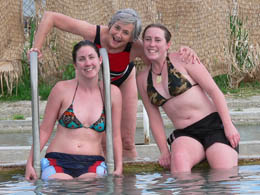
3 Fabulous Babes in hot water |
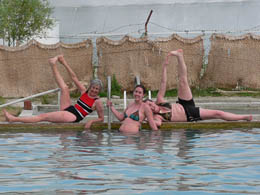
Poolside Yoga |
When the mud was ready, Kate, Mardi and I went into a steamy, dark room with 6 grave-sized pits filled with thick, gooey mud. The owner of the spa shoveled mud over our bodies. We laughed and threw mud at each other, then wiggled deeper down into the mud—a very nice experience. (Thought about mud wrestling, but didn’t.)
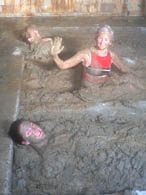
3 Fabulous Babes stuck in the mud |
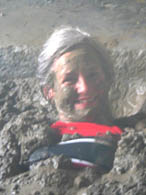
NiNi covered in mud |
After the mud bath, we took a hot mineral shower, then another swim in the pool, then a sauna, then a regular shower. We drove back to the Allgau to shower again before dinner. Still didn’t get all the mud out of my ears.
Ummu was waiting with another one of her divine dinners to die for (lentil soup, salad, green beans picked fresh from her garden, stuffed zucchini and stuffed peppers). Mardi and Kate joined us. After we couldn’t eat any more, Mardi finished off my salad. Adam and Kazim took the girls out to a sports bar to watch the World Cup Cricket match on TV. Bill and I talked to Steve and Janice, a friendly couple from Nova Scotia, both in their 50’s who had just arrived at the hotel. They were adorable – wish we had more time to hang out with them . . . but it’s on to Fethiye tomorrow.
|











